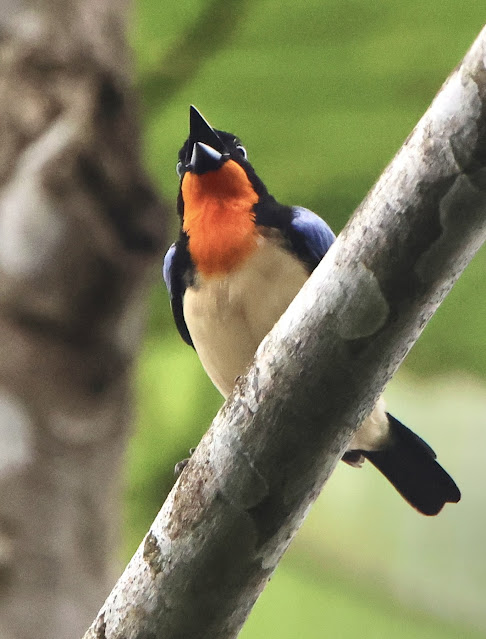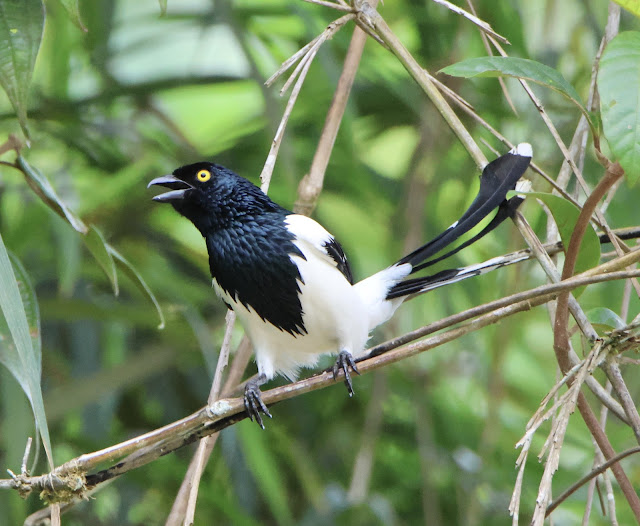Just up the road from Yankum, going south, is the Maycu Reserve. I’m not sure if it was set aside because of the rare tanager discovered there in 1964, or if it was already in place before its discovery.
After crossing the bridge and leaving the Nangaritza River this road goes uphill for about two miles and then gradually goes downhill, and only goes about a mile through a small part of this large reserve, most of which is inaccessible. The forest is full of trees and vines and the undergrowth is really thick.
There are 2 trails which ascend “up” to the top of the nearby tepuis, which is where there are a few other species which don’t often descend as low as the road, one of which is the Royal Sunangel, one I’d love to see, but did not want to expend the energy for the required 2 hour uphill hike. Carlos said he has done it 5X.
On January 5, our first full day in the area, Christian took us here. We ate at 5:30 and were on the road at 06:00. When we got there the birds were singing merrily, but as it was not quite good light yet, we were seeing mostly silhouettes. But in about 20 minutes Christian heard them, the Orange-throated Tanagers, the species the reserve protects.
ORANGE-THROATED TANAGER - A LITTLE BLURRY
We soon saw a few, but they stayed high in the trees, but certainly a flashy bird and it is easy to see why some come all the way here to see them. We saw 3 species of Trogons: Green-backed, Amazonian-white Tailed, and Blue-crowned. Two birds high on my list were Lined and Fasciated Antshrikes. Both were heard now and then, but only a pair of Lined made an appearance, and the female allowed a pic.
LINED-ANTSHRIKE- FEMALE
A little later on a Purplish Jacamar “finally” showed after numerous playbacks. He stayed put on the power line for a good 5 minutes, allowing me to maneuver for pics at different angles. He seems a little ragged, but that is the way he is suppose to look.
PURPLISH JACAMAR
Just after that a Dark-breasted Spinetail played hide and seek with us, only allowing 1-2 second glimpses, so certainly no pics. Another lifer which was fairly common were the Lemon-throated Barbets. Most of the ones we were seeing were females, but a flashy male finally showed well. Other lifers were Fulvous-shrike Tanager, Slaty-capped Shrike Vireo, White-eyed Tody Tyrant, Duida Woodcreeper, Olivaceous Woodcreeper, Lafresnaye’s Piculet, and Glittering-throated Emerald. For those of you who are not birders, these names will be truly foreign to you.
We tallied 60 species. I am sure I did not list all of them, especially if I was already familiar with them. I was not going to part with birding to look down at my iPhone where they’d need to be recorded. Sometimes it took an hour to move 200 meters because the birds were always around. It was a fun morning.
We returned again the next day for about 2 hours before traveling farther south. The birds were not as active as yesterday, and I was even more lazy about recording them all. The lifers were Thrush-like Wren, Ecuadorian Tyrannulet, Gray-tailed Piha, and Foothill Stipplethroat. Looking over my checklist I see I only tallied 3 tanager species, proof that I was lazy since there were plenty of others. We saw the Orange-throated Tanagers, but once again they stayed up in the tree tops.
After 2 hours of mozying along the road, we set off toward the village of Shaime, planning to bird along the 2 mile stretch of road prior to reaching that town. The road actually goes into Peru for a few hundred meters, so I had Christian stop there so we could place our feet on Peruvian soil, and bird for 5 minutes to acquire a short bird list for that country.
Soon after that we parked and then walked along the road. Some of the birds we saw/heard here were White Hawk, Black Caracara, White-bellied Pygmy Tyrant, Smooth-billed Ani, Double-toothed Kite, Little Woodpecker, Thrush-like Antpitta, Piratic Flycatcher, Scaly-breasted Wren and Yellow-bellied Dacnis.
ROADSIDE HAWK, THE MOST COMMON RAPTOR HERE
NO TRIP TO THE TROPICS IS COMPLETE WITHOUT A BLACK VULTURE. THEY ARE ALL OVER THE PLACE.
SMOOTH-BILLED ANI
WHITE HAWK
YELLOW-TUFTED WOODPECKER
DOUBLE-TOOTHED KITE
It was all basically downhill, and when we had gone far enough Christian went back to get his truck, in which time we saw a Cocoi Heron, which I did not think was a big deal as it was not flagged as rare in eBird. When Christian arrived I told him about it, and he was all excited asking “where, where,” as he had never seen one in the Zamora province. I had seen the heron across the river flying over some small ponds, but did not see where it landed, so we could not relocate it. It was like a state bird for the listers I’m familiar with, and he had come mighty close, but missed it. (We went for a boat ride up the Nangaritza River later that day, and we saw another one, so he was ecstatic about it).
On the 3rd day we returned in the afternoon, just Christian and I. It was a finale of sorts as the birds were thick and we moved rather slowly, and spent at least 3 hours there. What made it special was that some were more compliant in posing for pics this time. One let down was no Orange-throated Tanagers. I tallied some 58 species, but am sure some were missed. Lifers…….Gould’s Jewelfront (A really spiffy hummer), Ivory-billed Aracari, Peruvian Warbling-Antbird, Brown-billed Scythebill, Olive-faced Flycatcher, Sooty-headed Tyrannulet, Golden-bellied Euphonia, Flame-crested Tanager and a flock of about 100 Black-and-White Seedeaters.
AMAZONIAN WHITE-TAILED TROGON
Soon after we returned to the lodge, Christian went home. It was great having him guide us. He knew all the birds by sight, and almost all by their voice. With my fading sense of hearing I’m certainly at a loss in this country. After he left Carlos offered to take me back up to Maycu the next morning before breakfast. I really was hoping to sleep in but my instincts told me to accept his offer, so we took off in his van at 06:00 the next morning. Being 71 his hearing and vision are still in great shape. He knew right where to stop for the Orange-throated Tanagers, and in about 10 minutes he heard them. They were on the downhill side from us this time, implying that, while they were still in the treetops, at least the trees were lower on that side of the road.
In a couple minutes they began coming our way, and even came lower in the canopy. My camera now came to life and sounded like a machine gun at times as I wanted to make every opportunity count. Am sure I took at least 100 pics and more like 150+. Most were to be deleted, but one group was clear and worth keeping. (I had obtained some the first day, but they were blurry). I am becoming a perfectionist with photography, so always hope for the best. Another bird he heard and finally got me onto was a Musician Wren, my last (heard only) lifer.
ORANGE-THROATED TANAGER
Our 2 hours were soon up and we needed to head back for breakfast, but just down the road Carlos pulled over and said “Aracaris” and told me to get out. There was a group of 4 Chestnut-headed Aracaris having some kind of tussle, and were squawking up a storm, so here is my best shot of one.
CHESTNUT-EARED ARACARI
And so ended my visits to Maycu. I recorded 101 species there in those 4 visits. What a place! I’d return anytime. Christian said there were a lot more species we potentially could have found. As a matter of fact, on that last visit when he went back uphill to get his truck, he saw 3 species, 2 of which would have been new for me: Fiery-throated Fruiteater, Masked-crimson Tanager, and Rufous-rumped Antwren. Such is birding; always full of surprises.







































































